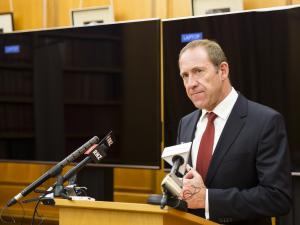Respiratory physician Lutz Beckert considers chronic obstructive pulmonary disease management, including the prevention of COPD, the importance of smoking cessation and pulmonary rehabilitation, and the lifesaving potential of addressing treatable traits. He also discusses the logic of inhaler therapy, moving from single therapy to dual and triple therapy when indicated, as well as other aspects of management
Verrall replaces Little as health minister
Verrall replaces Little as health minister

“I have full confidence in Andrew Little”
Ayesha Verrall is riding the up elevator of Cabinet rankings and takes over as health minister as Andrew Little goes down.
New prime minister Chris Hipkins, who took over the top job last week after Jacinda Ardern’s resignation announcement the week before that, spelled out his Cabinet changes in a live-streamed media conference this afternoon.
Another important change is that the COVID-19 response portfolio, which was held by Dr Verrall, seems to have disappeared. It isn’t in the new list, issued by the prime minister’s office today, of all portfolios and their ministers.
Mr Little, the health minister since November 2020 following Labour’s landslide election victory and driver of the Government’s health reforms, slips from number six in Cabinet to number 13.
Dr Verrall, who was an associate minister of health, takes on the full health portfolio and rises from number 17 to number eight. She retains research, science and innovation. An infectious diseases expert and fellow of the Royal Australasian College of Physicians, her current status on the Medical Council of New Zealand register is “not practising”.
Mr Little picks up the defence portfolio from Peeni Henare, who inherits ACC from new deputy prime minister Carmel Sepuloni.
Mr Little has led the scrapping of DHBs and the creation of new central health agencies Te Aka Whai Ora and Te Whatu Ora and the gradual start-up of iwi-Māori partnership boards and localities.
He has been, at times, a controversial figure in health, finding himself in occasional scraps with primary care over issues including what he considers outdated general practice business models, funding, and the exclusion of general practice from a nurse pay-parity package.
Most recently he has been engaged in an exchange of terse letters with General Practice Owners Association chair and specialist GP Tim Malloy.
Mr Hipkins was asked if Mr Little’s demotion in the rankings meant he had lost confidence in the one-time Labour leader.
“No, absolutely not,” the prime minister replied. “I have full confidence in Andrew Little. The balance I have been trying to strike here is to make sure we are providing opportunities to bring some of the new talent forward onto the front bench. Now naturally that means that some people move back off the front bench.”
In a media release, Mr Hipkins says of Dr Verrall: “An infectious diseases expert, she brings almost 20 years of knowledge of how our health system works and how it can be improved.”
Dr Verrall entered Parliament at the 2020 election on the Labour list.
Dr Malloy says he is surprised to see a change in the health portfolio so close to an election, particularly when health could be an election decider this time around.
“Do I think the incoming minister will bring something extra, yes I do,” says the Wellsford GP and practice owner. “And she will have health insight which I think has been missing in the recent past.”
“I for one, and I’m sure GenPro, will look forward to working with her to see if we can’t improve the communication between government and primary care.”
He adds that the new minister is still a “little bit of an unknown quantity” when it comes to her views on the Government’s major health policies. But she had done good work on COVID-19.
The New Zealand Nurses Organisation Tōpūtanga Tapuhi Kaitiaki o Aotearoa welcomes Dr Verrall to her new role.
Chief executive Paul Goulter says in a media release the ongoing pay equity dispute and lack of pay parity are among the biggest challenges the new minister will face this year.
"The lack of pay parity results in acute shortages of nurses in various sectors, as they move into the higher paid parts of health or leave the sector entirely.
"This means some sectors, such as primary health care, Māori and iwi, aged care, etc, cannot find or keep staff which leads to shortages that reduce health services in communities leading to poorer patient outcomes."
The prime minister's media release says the new Cabinet will be “focused on core bread and butter issues like the cost of living, education, health, housing and keeping communities and businesses safe”.
“We need a greater focus on what’s in front of New Zealanders right now. The new Cabinet line-up strengthens that focus,” Mr Hipkins says.
“In the reshuffle I have balanced the need for stability with renewal. New Zealanders want to see the Government getting on with the job but I also want to demonstrate the depth of our talent and bring some new energy and focus to the task ahead.”
Other Cabinet changes include transport minister Michael Wood becoming minister for Auckland and associate finance minister, and associate education minister Jan Tinetti taking on the full education portfolio previously held by Mr Hipkins.
Barbara Edmonds becomes minister of internal affairs, minister for Pacific peoples, and an associate minister of both health (Pacific peoples) and housing.
The new Cabinet positions take effect from tomorrow, 1 February.
We're publishing this article as a FREE READ so it is FREE to read and EASY to share more widely. Please support us and the hard work of our journalists by clicking here and subscribing to our publication and website







![Barbara Fountain, editor of New Zealand Doctor Rata Aotearoa, and Paul Hutchison, GP and senior medical clinician at Tāmaki Health [Image: Simon Maude]](/sites/default/files/styles/thumbnail_cropped_100/public/2025-03/Barbara%20Fountain%2C%20editor%20of%20New%20Zealand%20Doctor%20Rata%20Aotearoa%2C%20and%20Paul%20Hutchison%2C%20GP%20and%20senior%20medical%20clinician%20at%20T%C4%81maki%20Health%20CR%20Simon%20Maude.jpg?itok=-HbQ1EYA)
![Lori Peters, NP and advanced health improvement practitioner at Mahitahi Hauora, and Jasper Nacilla, NP at The Terrace Medical Centre in Wellington [Image: Simon Maude]](/sites/default/files/styles/thumbnail_cropped_100/public/2025-03/2.%20Lori%20Peters%2C%20NP%20and%20advanced%20HIP%20at%20Mahitahi%20Hauora%2C%20and%20Jasper%20Nacilla%2C%20NP%20at%20The%20Terrace%20Medical%20Centre%20in%20Wellington%20CR%20Simon%20Maude.jpg?itok=sUfbsSF1)
![Ministry of Social Development health and disability coordinator Liz Williams, regional health advisors Mary Mojel and Larah Takarangi, and health and disability coordinators Rebecca Staunton and Myint Than Htut [Image: Simon Maude]](/sites/default/files/styles/thumbnail_cropped_100/public/2025-03/3.%20Ministry%20of%20Social%20Development%27s%20Liz%20Williams%2C%20Mary%20Mojel%2C%20Larah%20Takarangi%2C%20Rebecca%20Staunton%20and%20Myint%20Than%20Htut%20CR%20Simon%20Maude.jpg?itok=9ceOujzC)
![Locum GP Helen Fisher, with Te Kuiti Medical Centre NP Bridget Woodney [Image: Simon Maude]](/sites/default/files/styles/thumbnail_cropped_100/public/2025-03/4.%20Locum%20GP%20Helen%20Fisher%2C%20with%20Te%20Kuiti%20Medical%20Centre%20NP%20Bridget%20Woodney%20CR%20Simon%20Maude.jpg?itok=TJeODetm)
![Ruby Faulkner, GPEP2, with David Small, GPEP3 from The Doctors Greenmeadows in Napier [Image: Simon Maude]](/sites/default/files/styles/thumbnail_cropped_100/public/2025-03/5.%20Ruby%20Faulkner%2C%20GPEP2%2C%20with%20David%20Small%2C%20GPEP3%20from%20The%20Doctors%20Greenmeadows%20in%20Napier%20CR%20Simon%20Maude.jpg?itok=B0u4wsIs)
![Rochelle Langton and Libby Thomas, marketing advisors at the Medical Protection Society [Image: Simon Maude]](/sites/default/files/styles/thumbnail_cropped_100/public/2025-03/6.%20Rochelle%20Langton%20and%20Libby%20Thomas%2C%20marketing%20advisors%20at%20the%20Medical%20Protection%20Society%20CR%20Simon%20Maude.jpg?itok=r52_Cf74)
![Specialist GP Lucy Gibberd, medical advisor at MPS, and Zara Bolam, urgent-care specialist at The Nest Health Centre in Inglewood [Image: Simon Maude]](/sites/default/files/styles/thumbnail_cropped_100/public/2025-03/7.%20Specialist%20GP%20Lucy%20Gibberd%2C%20medical%20advisor%20at%20MPS%2C%20and%20Zara%20Bolam%2C%20urgent-care%20specialist%20at%20The%20Nest%20Health%20Centre%20in%20Inglewood%20CR%20Simon%20Maude.jpg?itok=z8eVoBU3)
![Olivia Blackmore and Trudee Sharp, NPs at Gore Health Centre, and Gaylene Hastie, NP at Queenstown Medical Centre [Image: Simon Maude]](/sites/default/files/styles/thumbnail_cropped_100/public/2025-03/8.%20Olivia%20Blackmore%20and%20Trudee%20Sharp%2C%20NPs%20at%20Gore%20Health%20Centre%2C%20and%20Gaylene%20Hastie%2C%20NP%20at%20Queenstown%20Medical%20Centre%20CR%20Simon%20Maude.jpg?itok=Z6u9d0XH)
![Mary Toloa, specialist GP at Porirua and Union Community Health Service in Wellington, Mara Coler, clinical pharmacist at Tū Ora Compass Health, and Bhavna Mistry, specialist GP at Porirua and Union Community Health Service [Image: Simon Maude]](/sites/default/files/styles/thumbnail_cropped_100/public/2025-03/9.%20Mary%20Toloa%2C%20Porirua%20and%20Union%20Community%20Health%20Service%20in%20Wellington%2C%20Mara%20Coler%2C%20T%C5%AB%20Ora%20Compass%20Health%2C%20and%20Bhavna%20Mistry%2C%20PUCHS%20CR%20Simon%20Maude.jpg?itok=kpChr0cc)